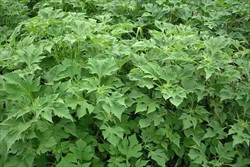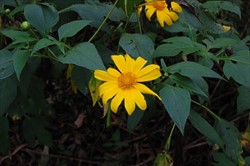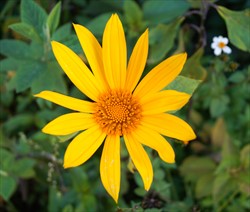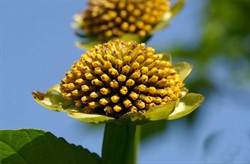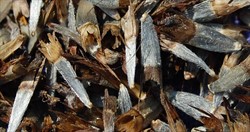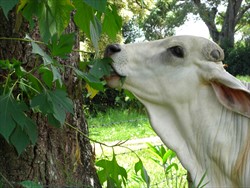Tropical Forages
Basionym: Mirasolia diversifolia Hemsl.
Family: Asteraceae (alt. Compositae) tribe: Asteroideae subtribe: Heliantheae.
Annual, short- or long-lived perennial, sub-shrub or shrub, erect to 2‒3 (‒5) m tall; potential to develop prostrate stems. Particularly large root volume has been reported. Leaves alternate; petiole 2‒6 cm; lamina ± deltate to pentagonal, 7‒33 × 7‒22 cm, mostly 3- or 5-lobed, margins dentate/serrate, apexes acute or acuminate, pubescent and slightly greyish on the underside; leaf venation palmate. Each mature stem may bear several flower heads (capitula) at the top of branches; capitulum solitary on a peduncle 6–24 cm long; phyllaries (involucral bracts) 16‒28, (3-or) 4-seriate, oblong to ovate, outer phyllaries 6‒10 × 4‒7 mm, abaxially usually glabrous, apex rounded to acute, inner phyllaries 10‒20 × 3‒10 mm, abaxially glabrous, apex rounded to acute; flower heads similar in appearance to the common sunflower but smaller; flower disc about 3 cm diameter; ray florets 7‒14; corolla yellow, lamina ("petals") linear, 30‒69 × 9‒16 mm, yellow; disk florets 80‒>120. Seeds are achenes, 4‒8 mm long and topped with a ring (pappus) of scales and two outer awns about 5 mm long; covered in close-lying hairs (appressed pubescent). 190,000 seeds per kg.
Africa: Mexikaanse sonneblom (Afrikaans); kirurite (Embu); marûrû (Kikuyu); ikicamahirwe (Kinyarwanda); ibamba-ry'umusozi, kererukonjo, umugaruro (Kirundi); amaua amaroro (Kisii); maua amalulu (Luhya); maua madonga, mava-madongo, otech, maua makech (Luo ); liuwa, lilulu (Marachi); cilula, chiharara (Mashi); jogbo, agbale (Okeigbo); maua (Swahili, Sukuma); cilula, hyasi hilulu (Shi)
Asia: 肿柄菊 zhong bing ju (China); harsaga, kembang mbulan (Javanese), srengenge leutik (Sundanese) (Indonesia); ニトベギク (Japan); บัวตอง daoruang-yipun; benchamat-nam; thantawan-nu (Thailand); dã quỳ (Vietnam)
English: Japanese sunflower, Mexican sunflower, shrub sunflower, tree marigold, Nitobe chrysanthemum, Mexican tournesol, Bolivian sunflower
Europe: tournesol mexicain, fleur la fête des mères, petite fleur soleil (French/French creole); mexikanische Sonnenblume, Riesen-Tithonie (German)
Indian subcontinent: காட்டுச் சூரியகாந்தி (Tamil); লম নুমিতলৈ lam numitlei (Manipuri); कनकगोल kanak gol (Marathi); kattu suryakanthi (Irula); काँडे पुतली फूल kaande putalee phool (Nepali)
Latin America: margaridão-amarelo, girassol mexicano (Brazil); árbol maravilla, árnica de la tierra, botón de oro, crisantemo de Nitobe, falso girasol, girasol mexicano, girasol japonés, girasolillo, guasmara, jalacate, margarita gigante, margarita isleña, margaritona, tornasol mexicano (Spanish)
Native:
Northern America: Mexico (Campeche, Chiapas, Guerrero, Michoacán, Oaxaca, Quintana Roo, Sinaloa, Tabasco, Veracruz, Yucatán)
Central America: Belize, Costa Rica, El Salvador, Guatemala, Honduras, Nicaragua, Panama
Cultivated/naturalized:
Throughout the tropics and subtropics.
Forage
Grazing in mixture with grasses and cut-and-carry forage for ruminants and monogastrics. The leaves, soft branches and even the plant’s yellow flowers are eaten.
Environment
Green manure, hedgerows for erosion control and bee forage.
Other
Soil requirements
Requires well-drained, moderately fertile soils. Is reported to tolerate acid, low-fertility soils and to have a high capacity of phosphorus uptake.
Moisture
Prefers mean annual rainfall in the range of 1,000‒2,000 mm, but tolerates 700‒>2,500 mm. Considered as moderately drought-resistant.
Temperature
Can be found at elevations up to 2,300 m asl; best growth where annual daytime temperatures are within the range 15–31 °C, but can tolerate 12‒38 °C.
Light
Prefers full sunlight; no particular shade tolerance reported.
Reproductive development
Flowers and produces seeds throughout the year. Mature plants can produce up to 900,000 seeds per square meter annually, with up to 93% viability. Seed can be disseminated by water flow, strong wind and adhering to animals. Field observations indicate that T. diversifolia is able to reproduce also clonally, especially during the rainy reason, when adventitious roots and young shoots rapidly emerge from nodes on lower or prostrate branches. Clonal growth contributes to horizontal expansion of patches and can lead to the creation of dense stands.
Defoliation
Recommended plant height for use of tithonia for forage (grazing or cutting) is 1.00‒1.50 m; suggested cutting height is 10‒15 cm. First grazing at 1.50‒1.80 m height, when plants have developed a strong root systems that will allow vigorous regrowth. Grazing must be rotational with an occupation time of no longer than 2 days and a rainfall-dependent rest period of 60‒90 days. Rapid regrowth. Post-flowering cuts result in higher yields than pre-flowering cuts. In lignified plants, 1‒2 standardization cuts/year at 20 cm height are suggested to stimulate leafy regrowth.
Fire
Tolerance of fire has been reported.
Guidelines for establishment and management of sown forages.
Establishment
Tithonia is usually propagated from stem cuttings of 20‒40 cm length, inserted vertically into the soil, 10‒20 cm deep (similar to planting of cassava). Direct sowing of seeds and transplanting to other areas of spontaneous seedlings emerged under the canopy are also options, the main benefit being that under optimum conditions the roots may grow deeper in the soil and improve plant growth. Suggested planting distances are in the range of 0.75‒2.0 m × 0.75‒2.0 m or, in cooler regions with less radiation, wider.
Fertilizer
There is no information on the effect of fertilizers on tithonia but the species can be expected to respond to application of production-limiting nutrients.
Compatibility (with other species)
Tithonia is reported to be suitable for association with a number of pasture grasses and shrub legumes.
Companion species
Grasses: Cynodon nlemfuensis, Megathyrsus maximus, Urochloa spp., Cenchrus clandestinus
Legumes: Gliricidia sepium
Pests and diseases
No major pests and diseases are known for T. diversifolia.
Ability to spread
T. diversifolia is can spread via both seed and young branches (clonal proliferation).
Weed potential
In some countries considered an invasive weed. In Australia it is rated as a serious environmental weed.
Nutritive value
For a non-legume, high nutritive value, which however decreases considerably with increasing plant age and development. CP 14‒28%; 84% moisture content, low fibre concentrations; digestibility 63‒65%; high DM degradability in sacco (90% after 48 h); P 0.29‒0.38%, Ca 2.0‒2.5%.
Palatability/acceptability
Moderate palatability to cattle and small ruminants .
Toxicity
There are reports on low concentrations of secondary metabolites (alkaloids, polyphenols, saponins, terpenes and others) which may be responsible for the moderate palatability of T. diversifolia to livestock and for affected growth (occasionally observed) of neighboring vegetation (phytotoxicity, allelopathy). One study showed that carcass traits and sensory characteristics of broilers wer adversely affected when dried leaf material comprised >4% of the ration.
Feedipedia link
Dry matter
Green matter production reported is in the range of 30‒70 t/ha/cut is reported as well as annual biomass yields of 60 t/ha at cutting intervals of 4 months.
Animal production
Livestock production has been improved by feeding tithonia; e.g. daily LWG of young bulls 643 g/animal when chopped grass was supplemented with tithonia vs. 509 g without. There are also reports on slightly increased milk production when tithonia was fed.
2n = 34.
Based on available information (up to 900,000 seeds/m²) seed production potential is high.
The following chemicals can be used in NSW Australia (https://weeds.dpi.nsw.gov.au/Weeds/JapaneseSunflower )
- Metsulfuron-methyl 300 g/kg + Aminopyralid 375 g/kg (Stinger™) at 20 g in 100 L of water; hand gun application; withholding period: 3‒56 days.
- Metsulfuron-methyl 600 g/kg (Brush-off®) at 10 g in 100 L of water applied to actively growing plants after full leaf expansion but before seed set. Add surfactant. Withholding period: Nil (recommended not to graze for 7 days before treatment and for 7 days after treatment to allow adequate chemical uptake in target weeds).
- Picloram 100 g/L + Triclopyr 300 g/L + Aminopyralid 8 g/L (Grazon Extra®) at 350 mL in 100 L of water applied as foliar spray pre-flowering Withholding period: Where product is used to control woody weeds in pastures there is a restriction of 12 weeks for use of treated pastures for making hay and silage; using hay or other plant material for compost, mulch or mushroom substrate; or using animal waste from animals grazing on treated pastures for compost, mulching, or spreading on pasture/crops.
- Picloram 44.7 g/kg + Aminopyralid 4.47 g/L (Vigilant II®) undiluted as cut stump/stem injection application. Apply a 3–5 mm layer of gel for stems less than 20 mm and 5 mm layer on stems above 20 mm. Withholding period: Nil.
- Triclopyr 300 g/L + Picloram 100 g/L (Grazon® DS) at 350 mL in 100 L of water applied as a foliar spray pre-flowering. Withholding period: Nil.
- High DM production potential .
- Adaptation to a wide range of climate and soils.
- Fast growth and regrowth.
- High nutritive value for a non-legume.
- High weed potential.
- Unclear allelopathic potential.
- Unclear importance of antinutritional factors.
- Low drought tolerance.
Hernández, I. and Sánchez, M.D. (2014) Small ruminant management and feeding with high quality forages in the Caribbean. Interamerican Institute of Cooperation in Agriculture (IICA), Santo Domingo, Dominican Republic. repositorio.iica.int/bitstream/11324/2611/1/BVE17038698i.pdf
Mahecha, L. and Rosales, M. (2005) Valor nutricional del follaje de botón de oro [Tithonia diversifolia (Hemsl.) Gray] en la producción animal en el trópico. Livestock Research for Rural Development 17:100. lrrd.org/lrrd17/9/mahe17100.htm
Mauricio, R.M., Calsavara L.H.F., Ribeiro, R.S., Pereira, L.G.R., Freitas, D.S. de, Paciullo, D.S., Barahona, R., Rivera, J.E., Chará, J. and Murgueitio, E. (2017) Feeding ruminants using Tithonia diversifolia as forage. Journal of Dairy, Veterinary & Animal Research 5(3)117–120. doi.org/10.15406/jdvar.2017.05.00146
Ruíz, T.E., Febles, G.J., Galindo, J.L., Savón, L.L., Chongo, B.B., Torres, V., Cino, D.M., Alonso, J., Martínez, Y., Gutiérrez, D.E., Crespo, G.J., Mora, L., Scull, I., La O, O., González, J., Lok, S., González, N. and Zamora, A. (2014) Tithonia diversifolia, its possibilities in cattle rearing systems. Cuban Journal of Agricultural Science 48:79–82. cjascience.com/index.php/CJAS/article/view/432
Savon Valdés, L.L., Gutiérrez Borroto, O. and Febles Pérez, G. (eds). (2017) Mulberry, moringa and tithonia in animal feed, and other uses. Results in Latin America and the Caribbean. Food and Agriculture Organization of the United Nations (FAO), Rome, Italy and Instituto de Ciencia Animal, San José de las Lajas, Cuba. https://www.feedipedia.org/sites/default/files/public/savonvaldes_2017.pdf
None released.
None reported.
